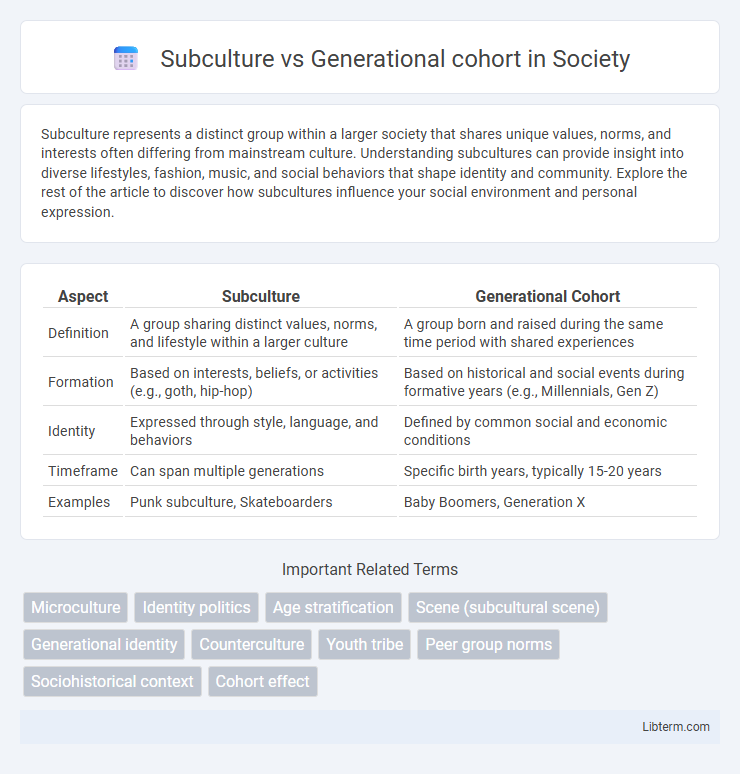Subculture represents a distinct group within a larger society that shares unique values, norms, and interests often differing from mainstream culture. Understanding subcultures can provide insight into diverse lifestyles, fashion, music, and social behaviors that shape identity and community. Explore the rest of the article to discover how subcultures influence your social environment and personal expression.
Table of Comparison
| Aspect | Subculture | Generational Cohort |
|---|---|---|
| Definition | A group sharing distinct values, norms, and lifestyle within a larger culture | A group born and raised during the same time period with shared experiences |
| Formation | Based on interests, beliefs, or activities (e.g., goth, hip-hop) | Based on historical and social events during formative years (e.g., Millennials, Gen Z) |
| Identity | Expressed through style, language, and behaviors | Defined by common social and economic conditions |
| Timeframe | Can span multiple generations | Specific birth years, typically 15-20 years |
| Examples | Punk subculture, Skateboarders | Baby Boomers, Generation X |
Defining Subculture: Unique Values and Practices
Subculture represents a distinct group within a larger culture characterized by unique values, beliefs, and practices that differentiate members from the mainstream society. Unlike generational cohorts, which are primarily defined by age and shared historical experiences, subcultures emphasize shared interests, lifestyles, and symbolic expressions such as fashion, language, and rituals. This differentiation helps marketers and sociologists identify targeted behaviors and preferences driven by identity rather than temporal factors.
Understanding Generational Cohorts: Shared Timeframes
Generational cohorts consist of groups of individuals born within specific timeframes who share common experiences and cultural influences that shape their behaviors and values. Unlike subcultures, which are defined by unique interests or lifestyles cutting across ages, generational cohorts are anchored in historical events and societal shifts experienced during formative years. Understanding these shared timeframes helps marketers and sociologists predict trends and preferences rooted in collective generational identity.
Key Differences Between Subcultures and Generational Cohorts
Subcultures are groups within a larger culture that share distinct values, norms, and behaviors often based on lifestyle, interests, or ethnicity, whereas generational cohorts consist of individuals born within the same time frame who experience similar historical and social events shaping their attitudes and behaviors. Key differences include the basis of identity--subcultures emphasize shared interests or cultural elements, while generational cohorts are defined by age and period-specific experiences. Marketing strategies must recognize that subcultures cut across age groups, while generational cohorts reflect shared temporal experiences influencing consumption patterns.
Origins and Influences: How Subcultures Form
Subcultures originate from shared interests, values, or lifestyles that differentiate a group within a broader society, often influenced by cultural, social, and environmental factors unique to their members. Generational cohorts form based on collective experiences, such as historical events, technological advancements, or economic conditions, that shape attitudes and behaviors of people born during the same time period. The formation of subcultures reflects localized or niche identities, while generational cohorts emerge from macro-level societal shifts affecting entire age groups.
The Impact of Major Events on Generational Identity
Major events such as wars, economic recessions, and technological revolutions play a crucial role in shaping generational cohorts by influencing their collective attitudes, values, and behaviors. Unlike subcultures, which form around shared interests or lifestyles within a generation, generational identity is deeply rooted in the historical context that defines an entire age group's worldview. For example, the Great Depression created a generation characterized by financial conservatism, while the digital revolution forged tech-savvy millennials with a distinct approach to communication and work.
Role of Media and Technology in Shaping Identity
Media and technology play a pivotal role in shaping identity within subcultures and generational cohorts by providing platforms for shared experiences and communication. Subcultures leverage niche online communities and social media to reinforce distinct values and styles, while generational cohorts are influenced by widespread access to technology during formative years, creating common cultural references. Digital content consumption patterns and technological adoption rates significantly impact how both groups express identity and maintain social cohesion.
Crossovers: When Subcultures and Generational Cohorts Intersect
Subcultures and generational cohorts intersect when specific cultural trends or values transcend age boundaries, creating shared identities that blend unique generational experiences with distinct subcultural characteristics. This crossover often manifests in music, fashion, and technology preferences, where individuals from different age groups adopt similar styles or behaviors rooted in subcultural movements. The dynamic interplay enhances cultural cohesion while preserving the nuances of both subculture identity and generational ethos.
Social Implications: Inclusion, Exclusion, and Stereotyping
Subcultures often create strong social bonds through shared values and practices, fostering inclusion for members while simultaneously excluding outsiders, which can lead to stereotyping and social marginalization. Generational cohorts, defined by birth periods and collective experiences, influence social identity by shaping attitudes and behaviors that differentiate age groups, sometimes resulting in intergenerational misunderstandings or biases. Both subcultures and generational cohorts impact social dynamics by reinforcing group boundaries that affect perceptions of belonging, inclusion, and exclusion within broader society.
Examples: Popular Subcultures vs Notable Generational Cohorts
Popular subcultures include goth, punk, and hip-hop, each characterized by distinct styles, music preferences, and values, shaping individual identity and social connections. Notable generational cohorts like Baby Boomers, Generation X, Millennials, and Generation Z represent large groups born within specific time frames, sharing common historical experiences and cultural trends that influence their collective behaviors and attitudes. While subcultures emphasize lifestyle and ideological expression, generational cohorts highlight broader demographic patterns and societal shifts.
Future Trends: Evolving Subcultures and Emerging Generations
Future trends in subculture and generational cohort analysis reveal increasing fluidity as digital connectivity fosters hybrid identities transcending traditional age boundaries. Emerging generations, such as Generation Alpha, exhibit unique values influenced by technological immersion and global challenges, reshaping cultural norms and consumer behavior. Evolving subcultures leverage social media platforms to rapidly disseminate niche cultural expressions, driving dynamic shifts in societal trends and lifestyle preferences across demographic segments.
Subculture Infographic

 libterm.com
libterm.com